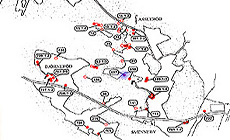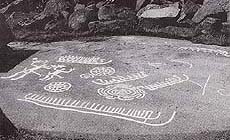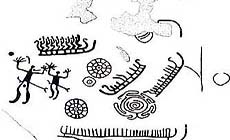|
|
 |
 |
Country: |
Sweden |
Locality: |
Askum rań 697 |
|
 |
Region: |
Bohuslńn |
Area: |
Askum |
|
 |
 |
|
|
|
|
| |
 |
Environment & Surface |
 |
 |
 |
|
Open-air
Shelter
Cave
Portable
Megalithic
|
Geography: |
The carving is situated on a crest of sloping rock, 20 m 210 c d of corner of field and 2 m SSE of stone wall. The surroundings consist of pasture land. |
Proximity: |
The carving is situated close to a stone wall, at the corner of a field. |
|
 |
Geology: |
Most probably granite. |
Surface: |
Smooth and flat surface, partly weathered. |
|
Dimensions:
|
Length 3.50 m.
Width 3.30 m.
|
|
 |
 |
|
|
|
|
| |
 |
Art |
 |
 |
 |
Description: |
Engravings
Paintings
Painted engravings
High or low-relief
Sculpture
The rock carving consists of a total number of 40 images, and the rock surface is partly weathered in the NNW part.
There are 5 ships, 69-159 cm
There are 17 human figures, 16-17 cm long. 15 are paddlers in one of the ships. The two single human figures, 72 and 58 cm long have completely carved out bodies; are phallic, equipped with swords and have big hands in adoration position.
|
Figures: |
total number 40
5 ships
17 human figures
6 ring figures
7 fragments
5 cup marks
|
|
 |
Chronology: |
Palaeolithic
Epipalaeolithic - Mesolithic
Neolithic
Copper Age
Bronze Age
Iron Age
Roman
Middle Age
Modern
Unknown
The South Scandinavian rock carvings are usually relatively dated to the middle and later part of the Bronze Age, c. 1500-500 BC, after Montelius six period system. Occasionally, the single localities can be dated based on typological comparisons with identifiable objects or decorative patterns. Askum RA─ 697 could possibly be dated to the later part of the South Scandinavian Bronze Age, based on the vivid scene and the meander pattern, as well as the swords with ferrule.
|
Notes: |
|
|
 |
 |
|
| |
 |
Bibliography |
 |
|
|
|
|
| |
 |
Conservation |
 |
 |
 |
Status: |
Public
Private
Park
Classified site
|
Risk: |
The major risk for rock carvings are chemical weathering, which makes the hard quartzite losen up and fall out, leaving white dots on the darker rock surface. Also natural weathering (mechanical weathering) during winter/spring, when water freeze in cracks and openings in the rock, creates major damage to rock faces with carvings. The biological weathering is also a danger to the rock carvings, and even to intense cleaning of the rock surface during documentation can make the rock fragile and expose the carvings to wind, water and air-born pollution. |
|
 |
Conservation: |
Good
Quite good
Mediocre
Bad
|
Intervention: |
Problems concerning conservation and preservation, registration and documentation of rock carvings in Scandinavia are discussed by several departments, i.e. Riksantikvaren in Norway, Riksantikvarieńmbetet in Sweden, several universities and research departments. Different methods are tested, for example covering of carved surfaces, measuring of temperature and different contents in water and air and also the composition in the granite. Hollows and cracks in the rock surface can be repaired and carefully filled in. An easy method of taking care of the rock surface is by ordinary sweeping. The Bronze Age environment has been restored by careful site management, mainly by clearing out pine-trees and the lower vegetation in order to create a more open and original environment. |
|
 |
 |
|
|
 |
By |
 |
|
| |
| Record n. 746 / 807 |
No commercial use is allowed. Specific ę is mentioned in the captions or owned by each Author or Institution |
|
| |
 |
EuroPreArt, European Prehistoric Art, is a web-based archaeological project funded by the European Union which aims to establish a lasting data-base of European prehistoric art documentation, to launch the base of an European institutional network and to contribute to the awareness of the diversity and richness of European Prehistoric Art.
It is proposed by: Instituto PolitÚcnico de Tomar (IPT, Portugal),
CUEBC - European University Centre for Cultural Heritage (Italy - Europe),
Consejo Superior de Investigaciones CientÝficas (España),
Asociaciˇn Cultural Colectivo Barbaˇn (España),
Université de Liège (Belgique),
Gotland University College (Sverige),
University College Dublin (Eire),
Cooperativa Archeologica Le Orme dell'Uomo (Italia),
Study Centre and Museum of Prehistoric Art of
Pinerolo (Italia),
The European Centre for Prehistoric Research in the Alto Ribatejo (Portugal),
ArqueoJovem - a youth NGO (Portugal).
|
|
|
|
 |
|
 NEW: Alpine rock paintings
NEW: Alpine rock paintings


